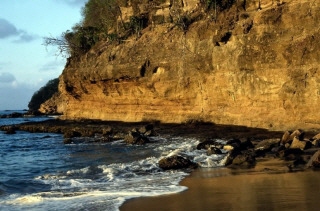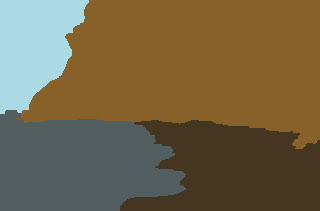L_WatershedBitmap (original) (raw)
Summary
Separates the image into different segments using the Watershed algorithm.
Syntax
#include "ltimgcor.h"
L_LTIMGCOR_API L_INT L_WatershedBitmap(pBitmap, ppPoints, pLengths, nSize)
Parameters
pBITMAPHANDLE pBitmap
Pointer to the bitmap handle.
L_POINT** ppPoints
Holds the initial point/path that represents the point or path from which to segment the bitmap.
L_INT* pLengths
Number of points in each path.
L_INT nSize
Number of paths.
Returns
| Value | Meaning |
|---|---|
| SUCCESS | The function was successful. |
| < 1 | An error occurred. Refer to Return Codes. |
Comments
Each segment's pixels have the same color. The Watershed algorithm treats an image as if it were a topographic surface.
The dark areas are basins. The light areas are the ridges around the basins.
The user is responsible for determining the number of output segments and the location of each segment in the input array.
This function supports 8- and 16-bit grayscale and colored images and 24- and 32-bit colored images.
This function does not support 32-bit grayscale images.
This function supports signed/unsigned images.
Watershed Segmentation Function - Before

Watershed Segmentation Function - After

View additional platform support for this Watershed Segmentation function.
Required DLLs and Libraries
- LTIMGCOR
- For a listing of the exact DLLs and Libraries needed, based on the toolkit version, refer to Files To Be Included With Your Application.
Platforms
Win32, x64, Linux.
See Also
Functions
Topics
- Raster Image Functions: Image Analysis
- Raster Image Functions: Processing an Image
- Processing an Image
Example
This example loads a bitmap and applies Watershed segmentation.
L_INT WatershedBitmapExample(L_VOID)
{
L_INT nRet;
BITMAPHANDLE LeadBitmap; /* Bitmap handle to hold the loaded image. */
/* Load the bitmap, keeping the bits per pixel of the file */
nRet = L_LoadBitmap(MAKE_IMAGE_PATH(TEXT("DICOM\\IMAGE3.dcm")), &LeadBitmap, sizeof(BITMAPHANDLE), 0, ORDER_BGR, NULL, NULL);
if (nRet != SUCCESS)
return nRet;
/* Apply a WatershedBitmap filter */
L_POINT* ppPoints[4] = {};
L_INT Lengths[4] = {};
L_INT nSize = 4;
for (L_INT i = 0; i < nSize; i++)
{
Lengths[i] = 2;
ppPoints[i] = (L_POINT*)malloc(Lengths[i] * sizeof(L_POINT));
if (ppPoints[i] == NULL)
{
for (L_INT j = 0; j < nSize; j++)
{
if (ppPoints[j] != NULL)
{
free(ppPoints[j]);
}
}
if (LeadBitmap.Flags.Allocated)
L_FreeBitmap(&LeadBitmap);
return ERROR_NOT_ENOUGH_MEMORY;
}
}
ppPoints[0][0].x = 35; ppPoints[0][0].y = 100;
ppPoints[0][1].x = 35; ppPoints[0][1].y = 200;
ppPoints[1][0].x = 180; ppPoints[1][0].y = 115;
ppPoints[1][1].x = 300; ppPoints[1][1].y = 115;
ppPoints[2][0].x = 235; ppPoints[2][0].y = 220;
ppPoints[2][1].x = 260; ppPoints[2][1].y = 220;
ppPoints[3][0].x = 180; ppPoints[3][0].y = 330;
ppPoints[3][1].x = 350; ppPoints[3][1].y = 330;
nRet = L_WatershedBitmap(&LeadBitmap, ppPoints, Lengths, nSize);
for (L_INT j = 0; j < nSize; j++)
{
free(ppPoints[j]);
}
if (nRet == SUCCESS)
nRet = L_SaveBitmap(MAKE_IMAGE_PATH(TEXT("Result.BMP")), &LeadBitmap, FILE_BMP, 24, 0, NULL);
//free bitmap
if (LeadBitmap.Flags.Allocated)
L_FreeBitmap(&LeadBitmap);
return nRet;
}